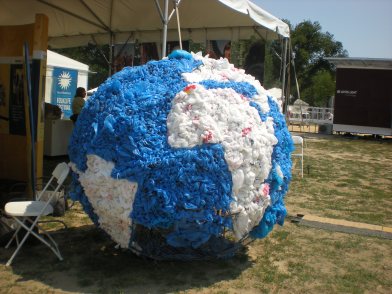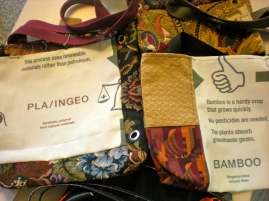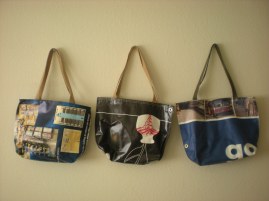I was happily surprised to learn that I saved 5 cents at Target for using my re-useable bag instead of plastic. I think incentives can help reduce the amount of plastic bags that people use, but it will take some time for people to fully convert to re-useable bags in place of double bags for groceries that seem more convenient.
I always take my small rolling backpack to the grocery store to be able to bring more groceries home on the bus and to also lighten the load on my shoulders and arms. This makes more sense to me than struggling to carry 5-7 bags of heavy groceries on the bus and walk up the hill. Below is an artistic interpretation of what the world can come to be if we continue to use plastic bags. This globe was created collaboratively at the 2012 Smithsonian Folklife Festival and was the idea of UC Davis Design professor Ann Savageau.
 With the availability of so many plastic bags, it is no surprise that plastic bags have become a sort of “invasive species” to several ecosystems. Even in landfills where the trash is supposed to be contained and controlled, plastic bags manage to fly away and get caught in the periphery fences. Workers have to hand-pick the bags out of fence to ensure that they don’t eventually escape into the city landscape. I was shocked when I learned this last Spring in a visit to Davis CA landfill.
With the availability of so many plastic bags, it is no surprise that plastic bags have become a sort of “invasive species” to several ecosystems. Even in landfills where the trash is supposed to be contained and controlled, plastic bags manage to fly away and get caught in the periphery fences. Workers have to hand-pick the bags out of fence to ensure that they don’t eventually escape into the city landscape. I was shocked when I learned this last Spring in a visit to Davis CA landfill.
I felt some relief that I’ve participated in several creative activities that propose the use of beautiful re-useable bags made from post-consumer textile waste. Below are bags constructed of interior fabric samples and vinyl banners that have reached people across different communities in the U.S.
The use of re-useable bags is one solution to reduce our use of plastic bags, but there are already several bags that pose threats to ecosystems. As mentioned earlier, these bag are like “invasive species.” Their impact on land is a nuisance as they can get caught in our feet as we walk by, but they threaten the livelihood of several aquatic species also. The appearance of plastic bags is similar to the look of jellyfish, and several aquatic species accidentally consume the plastic, mistaking it for jellyfish, and starve to death. Additionally, the plastic is not biodegradable and in the ocean it becomes small flakes that look like food and are also consumed. Plastic is a constant threat to living organisms, and its disposability makes it a greater danger.
Plastic bags have also reached the ocean’s coral reefs that contain one of the richest biodiverse ecosystems. Plastic bags harm coral reefs by suffocating them. Below is my artistic representation of how the plastic bag is invading the ecosystem of crochet coral reefs. (Special thanks to Nidia for letting me use some of hyperbolic structures.
These coral reefs seem so far away from Ithaca, but the idea of encountering an “invasion” by unwanted forces (whether it be fracking, hurricanes, snow storms, or greater urban development) is something we can relate to as a society. Empathizing with other organisms can lead to alterations in lifestyle habits that can limit our recurring threat to innocent ecosystems throughout the world.
References:





Plastic bags have been banned as of Jan 1st on the Big Island of Hawaii. Many are still not on board and the store uses double paper bags (which had always seemed better than the plastic anyhow) hard to get people to change but it is a start.